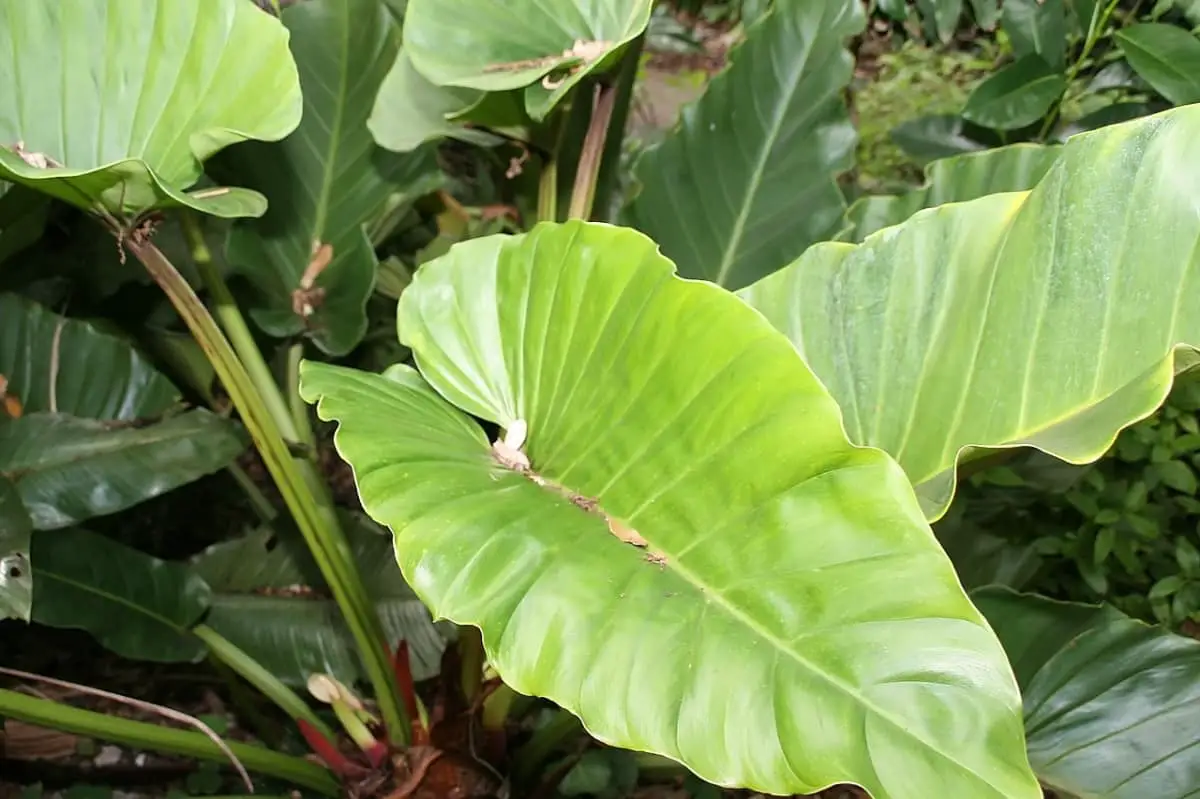
Image – Wikimedia Commons / David J. Stang
When you want to know more about plants, it is interesting to learn the names of all their parts. This can be useful, for example, in case you suspect that you have an illness and you want to do your best to recover, since you have to take into account that depending on the type of product you use and which part is affected , you will have to apply it one way or another. Knowing this, It is important that you know that the stem of the leaf is usually one of the most vulnerable.
But what is the stem of the leaf? There are many plants that do not have one, others instead develop a very long and robust one. In some cases, if they have it, it will not be green as one would expect, but a different color, such as that of many Colocasia cultivars, for example.
What is the technical name for the leaf stem?

His name is petiole. This is the part that joins the leaf to the stem of the plant. it is herbaceousso it is very fragile. This has its reason for being, and it is quite simple. To make it easier to understand, I am going to give you the example of a deciduous tree.
When temperatures begin to drop, it stops supplying them with food, so we can see that the color of their leaves changes: in many cases, as happens with maples or ash trees, the green gives way to different shades of red, yellow and /or oranges; then they turn brown (at this point they are completely dry, lifeless) and… what happens? well what the slightest breeze lets them fall easily, because the petiole is tender and also has not received food for a long time.
And not only that, but when the leaves fall to the ground, they do so very close to the trunk. This is very interesting, because When the tree decomposes, it will be able to recover part of the nutrients it used to produce them.. It is for this reason that, I think, removing those dead leaves is not the most appropriate, because ultimately we are talking about something that will end up being fertilizer for the plant. But let’s not get sidetracked.
There are certain types of plant beings that do not have woody or, in many cases, semi-woody stems: herbs (including megaphorbias, such as palm and banana trees) and bushes (or sub-shrubs) such as lavender fall into this group. Do these have petioles? It depends on the species. Lavender for example does not haveInstead, the leaves sprout directly from the main stem. But many others yes: palm trees, banana trees, ensetes, alocasias and colocasias, and a large number of plants do have them.
When a leaf has a stem that joins it to another stem, be it the branch or the trunk, for example, it is said to be a petiolate leaf; when not, it is said to have seated leaves, as it could give the impression that it “settles” on the stem.
What types of leaf stems are there?
Really more than different types of stems, we have to look at what the leaf that sprouts from it is like. For example, four types are distinguished:

Screenshot.
But, as you can see, the petiole fulfills the function of keeping the leaf attached to the rest of the plant, at least until said leaf reaches the end of its life.
Its duties?

Image – Flickr/Jungel Rebel
I have commented on one, which is the most basic, but really, without a petiole, many plants could not “hold” their leaves. So I am going to delve deeper into this topic, as the functions of this stem may surprise us:
Attach the leaf to the stem
Everything starts here. The petiole keeps the leaf attached to the rest of the plant, and with it, allows it to live and perform its normal functions.. But be careful, for this to really be possible you will need the support of a healthy root system, since after all they are the ones in charge of looking for water and nutrients and promoting them to the rest of the plant once they find them.
keeps the leaf alive
Even if it’s temporary, but as long as they’re alive, the plant will supply them with water and food (nutrients). These will reach the leaves through the conductive vessels (they would be something like the veins of our body) in the form of crude sap. Once they reach their destination, they will be transformed into food and will return to the roots in the form of elaborated sap. And all thanks, I insist, to the petiole.

Related article:
What is raw sap and processed sap
Allows plants to have large leaves
This point is closely related to the first thing we talked about. But, although it may seem logical, we do not always think about it. Many plants that we have in our homes or gardens are tropical or subtropical. They live in warm regions, where temperatures remain high and where, in addition, it rains frequently, so they can afford to have huge leaves. And it is that, the bigger they are, the more light they can capture, and the more food they can make. But that They could only do so if they have stems that are not only herbaceous, but also robust.
Our beloved elephant ear (Alocasia macrorrhizos) is a clear example of this. But there are many, many more: among others, the Colocasia, the Monstera deliciousor palm trees, plants that develop leaves whose length often exceeds three meters.
For this reason, although we can often overlook it, we must ensure that the stem of the leaf is well maintained, healthy, because without it the plants could run out of foliage.

